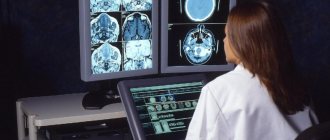Topographic cretinism is not a medical diagnosis, but rather a definition of a psychological problem that distinguishes some people. Cretinism is an endocrine disease and is not related to topographic cretinism. This problem, also called spatial cretinism, can be solved by various methods, including training and sessions with a psychologist.
Scientists claim that the biological compass, which is responsible for spatial thinking, is built, like a regular compass, on a magnetic field. Magnetite crystals in brain cells help the biological compass. A lack of magnetite can lead to the inability to navigate the terrain, and an excess can lead to the ability to find the right place even with your eyes closed. However, people with a brilliant sense of cardinal directions are very sensitive to magnetic storms and this is the other side of the coin.
Many famous people suffered from topographic disorder, for example, Christopher Columbus, who believed that he was heading to India, but in fact he was sailing to America. According to historical information, geographic cretinism was characteristic of the participants in the Battle of Borodino, commanders Napoleon and Kutuzov. As a result of incorrect calculations, the French and Russian armies almost missed each other.
Description of the phenomenon
This mental phenomenon is characteristic of many famous historical figures. Even Columbus, Kutuzov and Napoleon had manifestations of geographic cretinism.
In medical science, the disorder is not considered a complex pathology, so it is difficult to call it a disease. Almost every person had to seek help in an unfamiliar area. And some manage to easily find their destination the first time.
This phenomenon develops due to decreased activity of the right cerebral hemisphere, which is responsible for spatial orientation and has a “biological compass.”
Men, by their physiology, often have a more developed right hemisphere. This helps them navigate during various expeditions and travels. If we analyze who is more interested in hunting, fishing, and research travel, men will have a much higher percentage than women. Their three-dimensional imaginary map, created by the right hemisphere, helps to evaluate the sizes, shapes, and relationships of any surrounding objects.
Disorientation is not a lack of desire to remember the location of surrounding objects. It is also not dementia, cerebral ischemia, or organic brain damage. This phenomenon should not be confused with complex mental illnesses, although quite often it accompanies them. A person can remember information, but, due to brain damage, not use it. Or, conversely, the memorization process is disrupted, which leads to confusion and anxiety.
What is topographic cretinism?
Topographic disorientation is understood as a person’s absolute inability to navigate the terrain, even with a map, which is often accompanied by the fear of getting lost. The ability to find your way home is worsened by lack of sleep and panic, and improved by stress.
Neuroscience researchers believe that a person determines his location in space thanks to the hippocampus and areas of the cerebral cortex close to it. As stated in Olga Svarnik’s book “Brain in a Minute”, candidate of psychological sciences, place “neurons” in the hippocampus in rats were first described by the American neurophysiologist John O'Keefe in the 70s of the last century - then scientists discovered head direction neurons or gaze direction neurons , space boundary neurons, space lattice neurons. In 2014, John O'Keefe and the Norwegian neurophysiologists May-Britt and Evard Moser were awarded the Nobel Prize for their discovery of the mechanisms of navigation in space.
Topographic cretinism can be acquired (for example, as a result of injury or brain surgery) or congenital - some people have topographic disorientation since childhood, without obvious brain damage or any cognitive impairment. Such people often claim that similar problems are observed in their relatives, which indicates a genetic aspect.
The opinion that the inability to find a route on a map is inherited is also shared by Canadian neuroscientist Giuseppe Iaria. He also believes that "age-related topographical disorientation" is more common in women than in men: in Yaria's initial group of 120 people there were 102 women and only 18 men. Of course, this could have been caused by women being more open, but the difference is still quite large.
Risk factors and causes
There are certain reasons why orientation in space becomes difficult. It's connected with:
- gender characteristics - men have more developed logical thinking, they are able to navigate even in completely unfamiliar areas, representatives of the stronger sex rarely suffer from geographic cretinism;
- heredity - it has been proven that if both parents suffered from such a pathology, it is likely to manifest itself in the child;
- psychological trauma - often poor orientation in the area occurs due to panic experiences; if in childhood a person was lost, and this left a mark on his psyche, then in an unfamiliar situation he will experience fear and panic;
- impressionability - if the wrong choice of path or another unsuccessful first attempt is made, a person may experience hysteria and excessive emotionality, which prevent him from making the right decisions and finding his way around the area;
- unformed internal motivation - if a person does not want to look for the right path, the right decisions cause him hostility, this indicates that there is no motivation to find the right object;
- organic lesions of the right hemisphere, circulatory disorders in the brain.
Geographical cretinism. Solution
There are several ways to help poorly oriented people.
- We remember the landmarks. Shops, signs, everything unusual and bright that comes along the way.
- To train spatial thinking, it is useful to mentally draw maps of the area you are moving through, especially for the first time.
- Walking is a great exercise for geographic memory. When walking around your city or going about business, it is good to turn off your usual path and go to unfamiliar places, passageways, paths, while mentally drawing a map of the area.
- In order to understand exactly how you find the right route, imagine a familiar road, mentally mark all the landmarks on it, calculate the time of progress, taking into account that it takes more time to overcome difficult sections of the path. Plot your route on the map.
- You definitely need to find time to learn how to work with cards, this develops visual memory. Experienced people advise that if you are afraid of getting lost, carry atlases and maps of the area with you, this eliminates fear and really helps you navigate the route. To develop visual memory, remember the route you have taken and mentally reproduce it, remembering all the landmarks, people, and events.
- It is important to learn to distinguish landmarks by their reliability, for example, a parked car is a weak landmark, and a house is reliable; the more differences a house or building has, the better.
- Dancing and orienteering are good for pumping up the right hemisphere.
- Allocentric vision (the ability to look at yourself from the outside) allows you to quickly develop spatial thinking. Often imagine yourself from the outside, moving along a familiar route.
- The ability to navigate depends on good nutrition; the brain refuses to work on a starvation diet.
- When developing geolocation, you need to try to do without the help of GPS navigators, and also ask passers-by less, although as they say, “language will take you to Kiev,” but you should not trust passers-by too much, who, like you, can get confused in three pines.
- If in your childhood there were moments when you, lost, succumbed to panic, discuss them with your loved ones, work through the situation to get rid of its subconscious influence.
Symptoms
Disorientation in a particular area manifests itself even at a young age, when the child is constantly lost. He is constantly worried about losing sight of his parents.
This phenomenon is characterized by a person's inability to reconstruct an internal map of the area that allows him to find the right path. Such people have poorly developed spatial imagination. In children with developing topographic cretinism, lessons in drawing, geometry, geography, and physics cause increasing internal tension and reluctance to go to class. They feel inferior when they cannot answer a teacher’s question correctly and this is emphasized by him or their classmates.
In adolescence, a person himself begins to realize his inadequacy in finding a destination in a certain area. Geographic cretinism is characterized by forgetfulness and disorientation of a person, even where he has been several times. Sometimes this phenomenon is accompanied by the fear of getting lost.
Treatment and correction
Since the disorder is not a mental illness, treatment consists of removing the causes of its occurrence. In some cases, correction of this phenomenon is accompanied by the use of medications.
Magnetite is a substance that helps to navigate
It has long been noted that among those who find it difficult to find their way in an unfamiliar area, the overwhelming majority are women. It turns out that there is a completely scientific explanation for this.
Topographic cretinism, as numerous studies have found, manifests itself in people who have reduced activity in the right hemisphere, namely that part of it where the zones responsible for spatial perception of the world are located. There is also a so-called cognitive (personal) map of the surrounding space and a biological compass.
It is interesting that its principle of operation, like that of the well-known device, is based on a magnetic field. And this is helped by magnetite crystals contained in our brain cells. According to researchers, it is the lack of this substance that leads to the fact that a person can get lost in three pines. But the increased content of magnetite (by the way, very rare) leads to a simply phenomenal ability for a person to navigate in the cardinal directions, even with his eyes closed.
But, alas, everything has a downside, and this talent too - such people, it turns out, are incredibly sensitive to the so-called magnetic storms.
Map in my head
When we walk over the same area every day for a long time, a cognitive map is formed in our heads - this is the scientific term for the construction of three-dimensional maps in the human brain, which allow us to quite accurately mentally visualize the route.
Interestingly, it is not necessary to see the road. So, in 1998, scientists from Russia conducted an experiment to find out how visual memory affects the preparation of a route in the head. Blind and sighted people took part in the study. They were divided into two groups (each included both categories), which spent 10 days exploring the territory: for only one group it was a familiar area, for the other it was completely new.
The researchers later compared the cognitive maps of each participant in the experiment. The results showed that sighted people had the most accurate maps in unfamiliar areas. However, in familiar territory, the blind were distinguished by the accuracy of the maps. The fact is that blind people cannot use visual orientation. In fact, they calculate their every step and therefore can then easily reproduce the entire route.
How to train your memory
By the way, another cause of topographic cretinism is considered to be chronic lack of sleep and fatigue (and women suffer from it most often). This state of affairs ultimately leads to a disruption in the normal nutrition of brain cells, which, in turn, leads to a deterioration in all types of memory.
To train them and the ability to navigate that depends on it, first, of course, organize your daily routine, and then begin the exercises. To do this, look out the window for 30 seconds, try to remember everything you see - every detail. And then, turning away, retell everything you remember. To do this, you can invite a “judge” who will check the correctness of your description.
In transport, look at the person, and then, closing your eyes, recall every detail of his portrait in your memory. Imagine how he moves, how he speaks, etc. Open your eyes and check if you remember his appearance correctly.
Bad memory
If you can easily remember the name of your street and house number, the address of your grandmother, aunt and friend, then your memory is fine. But if you have to strain your brain and recall memories, perhaps your topographic cretinism is associated with poor memory. Psychologists advise making associations with any object you see on the road, or with the name of the street.
Read the names of the stores and build any chain of connections with their participation, for example: bookstore - Russian poet - Pushkin. By building such associative chains along the way, you can easily return back.
At first you will have to make an effort, but over time it will happen automatically.
Inattention
Many people, walking in new places, are completely immersed in their thoughts or talking on the phone and do not consider it necessary to remember their route. Memory development specialist Larisa Chetverova advises practicing a simple exercise that will help improve attentiveness.
— Any abilities can be developed to a greater or lesser extent. You need to train your attention. Learn to write with both hands - this is a powerful exercise for developing memory: for example, writing “mom” with one hand and “dad” with the other. Definitely at the same time: one hand does not wait for the other,” Chetverov shares his advice.
And a few final words
If we do not take into account the existence of serious pathologies that lead to complete disorientation of a person in space and the inability to assimilate new information (consequences of stroke, Alzheimer's disease, senile dementia, etc.), then topographic cretinism cannot be considered a very serious problem.
But, you must admit, it’s also stupid to give up on him. After all, the more often you get confused in your native area, the more problematic any trip will be for you. How can you enjoy beauty if you are constantly afraid of getting lost? Therefore, this problem must and can be dealt with. Don't be lazy and you will succeed!
Now let's train!
Topographic cretinism, however, has one good side. It turns out that people who are poorly oriented in space, as a rule, have well-developed visual memory. This means that memorable bright landmarks can always help you find your way: billboards, store signs, unusual houses. But training won't hurt either:
- try to walk more, look for new paths to familiar objects;
- use your navigator as little as possible, although you can always take it with you - this will give you confidence;
- draw a map of a familiar area in your mind - look at your street from above, imagine where and what kind of house is located;
- when you find yourself in an unfamiliar place, try to do the same - if it’s in the same city, try to mentally connect the familiar area with the new one.
Reason 1. Women's
“If you were born a girl, be patient” - remember the rhyme? It turns out that a woman’s hard lot is not only when they first pull your pigtails and then whine “Well, marry me...” It is also a frequent inability to navigate in space. Psychologist Boris Kulebyakin explains: “A male hunter who went long distances needed to be well oriented in space, to imagine the area in his mind in order to return home with his prey. Women did not go far from home, and even if they went to pick mushrooms or berries, they were obviously guided by already known details - a tree is broken here, a stone lies there... Hence the difference in spatial perception. Men usually use general reference points - cardinal directions, for example. Ladies remember specific objects: a store where she bought shoes, a cafe where they don’t know how to make coffee at all, a billboard with a vacuum cleaner “like a friend’s”... Women’s ability to navigate the area is often hindered by the inability to quickly make a choice at a crucial moment. For men, logic comes first, while ladies usually live by emotions. Physiologists generally argue that women are not like people: the hemispheres of the brain constantly interact, or rather, compete, fighting for a kind of leadership. So the phrase “I’m so mysterious and unpredictable” is absolutely true. When solving spatial problems, this property of female nature only interferes.











